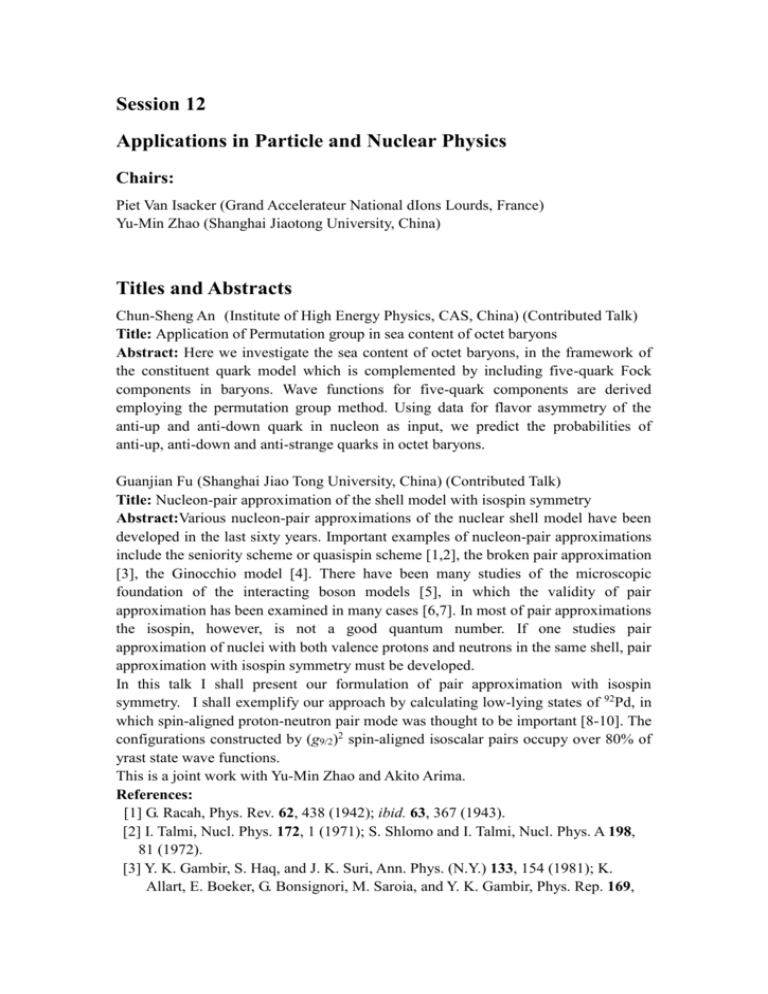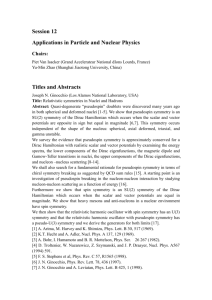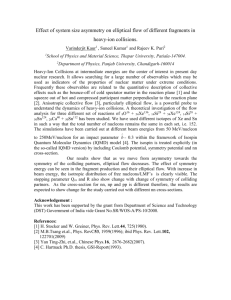Titles and Abstracts
advertisement

Session 12 Applications in Particle and Nuclear Physics Chairs: Piet Van Isacker (Grand Accelerateur National dIons Lourds, France) Yu-Min Zhao (Shanghai Jiaotong University, China) Titles and Abstracts Chun-Sheng An (Institute of High Energy Physics, CAS, China) (Contributed Talk) Title: Application of Permutation group in sea content of octet baryons Abstract: Here we investigate the sea content of octet baryons, in the framework of the constituent quark model which is complemented by including five-quark Fock components in baryons. Wave functions for five-quark components are derived employing the permutation group method. Using data for flavor asymmetry of the anti-up and anti-down quark in nucleon as input, we predict the probabilities of anti-up, anti-down and anti-strange quarks in octet baryons. Guanjian Fu (Shanghai Jiao Tong University, China) (Contributed Talk) Title: Nucleon-pair approximation of the shell model with isospin symmetry Abstract:Various nucleon-pair approximations of the nuclear shell model have been developed in the last sixty years. Important examples of nucleon-pair approximations include the seniority scheme or quasispin scheme [1,2], the broken pair approximation [3], the Ginocchio model [4]. There have been many studies of the microscopic foundation of the interacting boson models [5], in which the validity of pair approximation has been examined in many cases [6,7]. In most of pair approximations the isospin, however, is not a good quantum number. If one studies pair approximation of nuclei with both valence protons and neutrons in the same shell, pair approximation with isospin symmetry must be developed. In this talk I shall present our formulation of pair approximation with isospin symmetry. I shall exemplify our approach by calculating low-lying states of 92Pd, in which spin-aligned proton-neutron pair mode was thought to be important [8-10]. The configurations constructed by (g9/2)2 spin-aligned isoscalar pairs occupy over 80% of yrast state wave functions. This is a joint work with Yu-Min Zhao and Akito Arima. References: [1] G. Racah, Phys. Rev. 62, 438 (1942); ibid. 63, 367 (1943). [2] I. Talmi, Nucl. Phys. 172, 1 (1971); S. Shlomo and I. Talmi, Nucl. Phys. A 198, 81 (1972). [3] Y. K. Gambir, S. Haq, and J. K. Suri, Ann. Phys. (N.Y.) 133, 154 (1981); K. Allart, E. Boeker, G. Bonsignori, M. Saroia, and Y. K. Gambir, Phys. Rep. 169, 209 (1988). [4] J. N. Ginocchio, Ann. Phys. 126, 234 (1980); C. L. Wu, D. H. Feng, and M. Guidry, Adv. Nucl. Phys. 21, 227 (1994). [5] A. Arima and F. Iachello, Phys. Rev. Lett. 35, 1069 (1975); F. Iachello and A. Arima, the Interacting Boson Model, (Cambridge University Press, 1987). [6] Jin-Quan Chen, Bing-Qing Chen, and Abraham Klein, Nucl. Phys. A 554, 61 (1993); Jin-Quan Chen, ibid. 562, 218 (1993); Jin-Quan Chen, ibid. 626, 686 (1997); Y. M. Zhao, N. Yoshinaga, S. Yamaji, J. Q. Chen, and A. Arima, Phys. Rev. C 62, 014304 (2000). [7] Y. M. Zhao and A. Arima, (review) to be published. [8] B. Cederwall et al., Nature 469, 68 (2011). [9] C. Qi, J. Blomqvist, T. Back, B. Cederwall, A. Johnson, T. J. Liotta, and R. Wyss, Phys. Rev. C 84, 021301 (2011). [10] S. Zerguine and P. Van Isacker, Phys. Rev. C 83, 064314 (2011). Joseph N. Ginocchio (Los Alamos National Laboratory, USA) Title: Relativistic symmetries in Nuclei and Hadrons Abstract: Quasi-degenerate “pseudospin” doublets were discovered many years ago in both spherical and deformed nuclei [1-5]. We show that pseudospin symmetry is an SU(2) symmetry of the Dirac Hamiltonian which occurs when the scalar and vector potentials are opposite in sign but equal in magnitude [6,7]. This symmetry occurs independent of the shape of the nucleus: spherical, axial deformed, triaxial, and gamma unstable. We survey the evidence that pseudospin symmetry is approximately conserved for a Dirac Hamiltonian with realistic scalar and vector potentials by examining the energy spectra, the lower components of the Dirac eigenfunctions, the magnetic dipole and Gamow-Teller transitions in nuclei, the upper components of the Dirac eigenfunctions, and nucleon –nucleus scattering [8-14]. We shall also search for a fundamental rationale for pseudospin symmetry in terms of chiral symmetry breaking as suggested by QCD sum rules [15]. A starting point is an investigation of pseudospin breaking in the nucleon-nucleon interaction by studying nucleon-nucleon scattering as a function of energy [16]. Furthermore we show that spin symmetry is an SU(2) symmetry of the Dirac Hamiltonian which occurs when the scalar and vector potentials are equal in magnitude. We show that heavy mesons and anti-nucleons in a nuclear environment have spin symmetry. We then show that the relativistic harmonic oscillator with spin symmetry has an U(3) symmetry and that the relativistic harmonic oscillator with pseudospin symmetry has a pseudo-U(3) symmetry and we derive the generators for both limits [17]. [1] A. Arima, M. Harvey and K. Shimizu, Phys. Lett. B 30, 517 (1969). [2] K.T. Hecht and A. Adler, Nucl. Phys. A 137, 129 (1969). [3] A. Bohr, I. Hamamoto and B. R. Mottelson, Phys. Scr. 26 267 (1982). [4] D. Troltenier, W. Nazarewicz, Z. Szymanski, and J. P. Draayer, Nucl. Phys. A567 (1994) 591. [5] F. S. Stephens et al, Phys. Rev. C 57, R1565 (1998). [6] J. N. Ginocchio, Phys. Rev. Lett. 78, 436 (1997). [7] J. N. Ginocchio and A. Leviatan, Phys. Lett. B 425, 1 (1998). [8] J. N. Ginocchio and D. G. Madland, Phys. Rev. C 57, 1167 (1998). [9] J. N. Ginocchio, Phys. Rev. C59, 2487 (1999). [10] P. von Neumann-Cosel and J. N. Ginocchio, Phys. Rev. C62, 014308 (2000). [11] J. N. Ginocchio and A. Leviatan, Phys. Rev. Lett. 87, 072502 (2001). [12] B. Bowlin, A. S. Goldhaber, and C. Wilkin, Zeitschrift fur Physik A 331, 83 (1988). [13] J. N. Ginocchio, Phys. Rev. Lett. 82, 4599 (1999). [14] H. Leeb and S. Wilmsen, Phys. Rev. C62, 024602 (2000). [15] T. D. Cohen, R. J. Furnstahl, K. Griegel, and X. Jin, Prog. in Part. and Nucl. Phys. 35, 221 (1995). [16] J. N. Ginocchio, Physical Review C65, 054002 (2002). [17] Joseph N. Ginocchio, Phys. Rev. Lett. 95, 252501 (2005). Yu-Xin Liu (Peking University, China) Title: Some Fundamental Aspects of Many Particle Systems in Group Theoretical Approach Abstract: The system composed of many particles each of which has angular momentum ji holds the symmetry U ( (2 ji 1)) . The possible total angular i momenta of the system and their multiplicities, the values of the interaction matrix elements, and the criterion to check the correctness of the computational code evaluating the eigenvalue problem are the fundamental aspects in studying the properties of the system. Basing on the Lie group representation theory, we have given a simple recursion formula to get all the multiplicities of the total angular momenta and an explicit expression for the d-boson system. To get the one-body and two-body interaction matrix elements of the system with any possible seniority and total angular momentum, one needs the isoscalar factors (ISF) of the reductions U ( N ) O( N ) , U ( N ) SP( N ) , O( N ) O(3) and SP( N ) O(3) . We have also given the recursion formulae and the computational codes to get the matrix elements. As for checking the correctness of the code to evaluate the eigenvalues, we have developed a group chain approach based on the general principle of symmetry of a system. Yanan Luo (Nankai University, China) Title: SD-pair shell model for even-even system Abstract: The SD-pair shell model (SDPSM) is shown to reproduce approximately typical spectra, E2 transition strengths of the U(5), SO(6), SU(3) and SU^*(3) limits of the interacting boson model (IBM). The shape phase transitional patterns of the IBM can also be reproduced in the SDPSM. As an example, the experimental data for Xe and Ba isotopes are studied and the results show that the SDPSM can produce the experiments very well. This analysis confirms that the IBM has a sound shell-model foundation; it also demonstrates that the truncation scheme adopted in the SDPSM is reasonable. Feng Pan (Liaoning Normal University, China) Title: The Heine-Stieltjes correspondence and the polynomial approach to the SU(2) Gaudin-Richardson models Abstract: The Heine-Stieltjes correspondence is extended to the cases corresponding to the Bethe ansatz equations of the SU(2) Gaudin-Richardson models, with which a new polynomial approach to exact solutions of such quantum many-body problems is established. As examples of the application, the extended Heine-Stieltjes polynomials resulting from the solution of the two-site Bose-Hubbard model and those for the standard nuclear pairing model are discussed. The new approach may be used to search for exact solutions of a large class of quantum many-body problems and to establish a new angular momentum projection technique. Jialun Ping (Nanjing Normal University, China) Title: The group theoretic method in the multi-quark system study Abstract: A group theoretic method for the systematic study of multiquark states is developed. The calculation of matrix elements of many-body Hamiltonians is simplified by transforming the physical bases (quark cluster bases) to symmetry bases (group chain classified bases), where the fractional parentage expansion method can be used. Five- and six-quark systems are taken as the example in this study. Three quark models are used to show the general applicability of the new multiquark calculation method and general results of constituent quark models for five- and six-quark states are given. Chong Qi (Royal Institute of Technology, Sweden) Title: Analytic study of the partial seniority conservation Abstract: A partial conservation of the seniority quantum number in j = 9/2 shells has been found recently in a numerical application. In this contribution I will present an analytic proof for this problem. I will analyze the properties of the non-diagonal matrix elements with the help of the one-particle and two-particle coefficients of fractional parentage (cfp's). It is found that all non-diagonal (and the relevant diagonal) matrix elements can be re-expressed in closed forms and are proportional to certain one-particle cfp's. This remarkable occurrence of partial dynamic symmetry is the consequence of the peculiar property of the j = 9/2 shell, where all v = 3 and 5 states are uniquely defined. Fan Wang (CPNPC, Nanjing University and CAS, China) Title: Group representation versus Quantum representation and a New approach to group representation calculations Abstract: We developed a group representation theory and calculation method based on quantum representation theory. All the calculations, such as Character, Irreducible bases and Matrices, Projection operators, Clebsch-gordan series and coefficients are reduced to solve a set of eigan-equations of a complete set of commuting operators consisting of the class operators of the group. This approach had been successfully applied to all of the finite groups and compact Lie groups and various useful coefficients for physical application of group representation theory had been calculated and tabulated. Feng-Shou Zhang (Beijing Normal University, China) Title: Effects of symmetry and shell structure in heavy ion fusion reactions Abstract: The magic numbers were successfully explained by the nuclear shell model proposed by Gopper-Mayer and Jensen sixty years ago. The shell model predicts that the next doubly magic nucleus in the sequence will contain either 114, 120, 124 or 126 protons and 184 neutrons. However, the dynamical process of the formation of superheavy nucleus is not understood well enough. In this work, by using an improved isospin dependent molecular dynamics model in which the shell correction energy of the system is calculated by using deformed two-center shell model and the surface energy of the system is improved by introducing a switch function that combines the surface energies of projectile and target with the one of the compound nucleus, the effects of the shell correction energy on synthesis of superheavy nuclei and the fusion cross sections in asymmetric and nearly symmetric reaction systems leading to the same compound nuclei are studied. The entrance channel mass asymmetry dependence of compound nucleus formation is found by analyzing the shell correction energies, Coulomb barriers and fusion cross sections. The calculated results are in agreement with the experimental data and it is found that the compound nucleus formation is favorable for the systems with larger mass asymmetry. Yu Zhang (Liao Ning Normal University, China) (Contributed talk) Title: Euclidean dynamical symmetry in understanding nuclear shape phase transition Abstract: An algebraic realization of Euclidean dynamical symmetry is proposed, and its application to explore shape phase transition in nuclei is discussed. Some extensions about the present discussion are also mentioned. Yu-Min Zhao (Shanghai Jiaotong University, China) Title: The SO(3) symmetry for a single-j shell and the Pauli principle Abstract: In the nuclear shell model, number of states with given total angular momentum and angular momentum coupling coefficients are fundamental practices. I would like to present some analytical formulas of the dimension of a single-j shell, many new sum rules of angular momentum coupling coefficients for a single-j shell, as well as their relations via the Pauli principle.


![[1]. In a second set of experiments we made use of an](http://s3.studylib.net/store/data/006848904_1-d28947f67e826ba748445eb0aaff5818-300x300.png)
